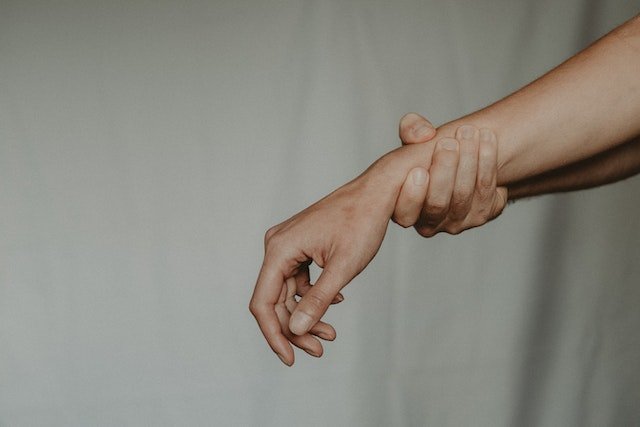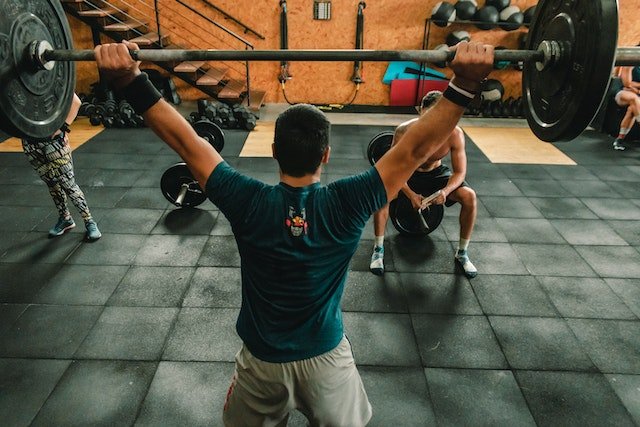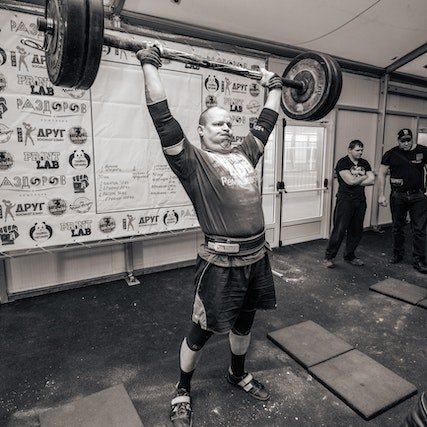
Wrist Pain From Overhead Press? Find Out How To Fix Here
Has wrist pain from the overhead press ever stopped you or slowed you down in the gym? If so, you’re not alone.
Wrist pain is a common issue for anyone doing upper body exercises and can cause discomfort during your workout as well as in everyday activities.
But don’t worry – there are many ways to address this issue and keep your wrists healthy while still getting the most out of your workouts.
In this blog post, we’ll explore what causes wrist pain from overhead press and how to prevent it. Keep reading to learn more about how you can take steps to protect yourself against injury!
Wrist pain from overhead press?
Wrist pain can be caused by a number of factors, including incorrect grip width and improper form. Gripping too hard or gripping the bar with your fingers instead of your palms can also lead to pain and irritation in the wrists. Bending your wrists back (wrist extension) or using a “suicide grip” (thumbless grip) can also contribute to wrist discomfort, as you should keep your wrist in a neutral position. In addition, using too much weight or overuse during day-to-day tasks can also lead to wrist pain and even injury. Common wrist injuries which might be highlighted when doing overhead press include – carpal tunnel syndrome, wrist tendinitis, wrist impingement, muscle or tendon strain, ligament sprain, and repetitive stress causing irritation.
Why does my wrist hurt when I do overhead press? Let’s investigate a few reasons why this may be happening…
It’s new to you
If you are new to lifting and the overhead press, your wrists may be unprepared for the load and pressure that comes with it.
Wrist strength is a key component of this lift and when you don’t have adequate grip strength, stabilizing the bar can become difficult.
When first starting out, it’s important to find the right weight for you and focus on form. Your wrists might not have the adequate strength to handle heavier weights, so easing into things is beneficial.
Your grip strength might also not be up to the task straight away, so it’s important to be aware of this. Wrist curls and other grip-strengthening exercises are good places to start in order to build up your grip strength.
If you haven’t really done any kind of lifting before, then your body is going to take some time to get used to the new movements and weights.
The new stimulus can be a shock to the system and your wrists may not be able to handle it at first because you haven’t done this kind of thing in a while (or ever).
If lifting is new to you, your body is going to take a little bit of time to get used to the new movements and weights, so don’t be discouraged if it takes a while to get there.
After a few weeks of really focusing on form and slowly increasing the weight, your body will start to adapt and you’ll find that your wrists will be more prepared for the overhead press.
Grip width
Grip width is another factor that can cause wrist pain when doing an overhead press. A wide grip puts more stress on your wrists as you move the bar overhead.
This is because it’s harder to stabilize the bar and keep it in line with your shoulders.
To prevent wrist pain, you should use a narrower grip which will be more comfortable and help you keep the bar closer to your body.
Make sure you are gripping the bar tight enough to keep it stabilized, but not so tight that it causes your wrists to bend too much.
If your grip is too narrow, this will also cause wrist pain as it increases the range of motion for your wrists and forearms and your wrists won’t be in a neutral position…they will be bent back.
Both wide and narrow grips can lead to wrist pain, so make sure that you find the right balance for your body and grip width.

Gripping too hard
It’s important to find the right balance when gripping the bar. Gripping too hard can lead to wrist pain due to the extra tension on your wrists.
For example, if you clench your fist as hard as you can, see how long you can do so before your wrists start to fatigue and hurt.
Now, compare that to your grip strength when doing an overhead press. If you’re gripping the bar too hard and holding onto it too tightly, then this could be the cause of your wrist pain.
Gripping too hard will primarily put extra strain on your wrists, but the tension will also be felt throughout your forearms and shoulders as well, which in turn will hinder the results of your workout.
Try to grip the bar just hard enough so that it won’t slip out of your hands, but not too tight that your knuckles are white and it causes extra tension on your wrists.
Handle placement
You should be gripping the bar with your palms and not your fingers. If you are gripping the bar too far up in your hands, this could also be causing your wrists to hurt.
This is because you are not utilizing the full strength of your hands and forearms, which will make it harder to stabilize the bar.
When gripping the bar with your fingers, you are not able to stabilize it as well and this can cause your wrists to bend and flex too much.
Make sure you are gripping the bar near the base of your palms and not in your fingers, to give yourself the best chance of keeping your wrists in a neutral position.
Related: Does shoulder press work side delts?
Wrist extension
When you are pushing the bar overhead, make sure that your wrists are not extending too far back. Wrist extension puts a lot of strain on your wrists, which can lead to pain and injury over time.
If your wrists are bending too far back, then you should adjust your grip on the bar and make sure you are gripping it closer to the base of your palms.
In addition, make sure that you are bringing the bar up straight and not allowing it to deviate from its path (this can also cause your wrists to bend too far back).
Your wrists want to remain as straight (neutral) as possible throughout the movement of the exercise so that your wrists aren’t having to work harder than they need to.
If you find that your wrists are bending too far back during the overhead press, then make sure to adjust your form and grip accordingly.
Suicide grip
The “suicide” grip is when you hold the bar with your thumbs over the top of the bar (instead of around it).
This type of grip is more common with bench press, but it can also be used for the overhead press. Using a suicide grip puts extra strain on your wrists and increases the risk of wrist pain.
This is not recommended as it places more strain on your wrists than a standard grip, and can lead to wrist injuries if done for extended periods of time.
The reason why people may use it while doing overhead press is that it’s not as stressful on your joints and doesn’t reduce your range of motion.
That said, you’re putting yourself in a dangerous position by not holding on to the bar properly, and it’s best to avoid this type of grip with this exercise as the risk of injury is too high, even if it does feel more comfortable.
Too heavy
One of the most common reasons why people have wrist problems when performing overhead presses is because the weight they are trying to lift is too heavy for them.
If you’re using too heavy of a weight, this can also lead to wrist pain because your body isn’t able to stabilize the bar properly and the wrists are having to work overtime to maintain the stability of the load.
When attempting to lift a heavy weight, make sure that you start with a lighter weight and then gradually increase the weight as you become stronger.
Work within a respectable rep range of 8-12, and only increase the load when you can comfortably lift the weight without putting too much stress on your wrists.
This will help to ensure that your wrists are not overworked, and in turn, will help to reduce the risk of injury.
When your wrists are overloaded with more weight than they can handle, this is when wrist pain and injury occur.

Poor form
Poor form is another common cause of wrist pain and injury. When performing overhead presses, make sure that you are using proper form to ensure that your wrists are in the correct position.
Your form should be such that your elbows stay close to your body, and you keep them in a slightly bent position throughout the movement.
In addition, make sure that your elbows are pointing down and not out to the sides as this will help to reduce the stress on your wrists.
Engage your core and glutes and make sure your back is flat before you start the lift, and try to keep your body tight throughout the entire movement.
Keep a solid frame throughout and make sure that you are not allowing your wrists to bend too far back or too far forward.
Finally, make sure that you are keeping your shoulders back and down throughout the entire movement. This will help to reduce the stress on your wrists, and will also help you to lift more weight.
Weak wrists, injury or overuse
If your wrists are weak, then it is important to focus on strengthening them before attempting an overhead press.
If you have experienced wrist problems or injuries in the past, it is vital that you take steps to protect your wrists while working out.
Similarly, if you have recently recovered from any kind of wrist injury, then it is important to wait until your wrists are fully healed before attempting any kind of exercise.
If you continue with an overhead press too quickly after an injury or if you do not strengthen your wrists enough, then this can lead to further damage.
Make sure you have a solid rehabilitation program for your wrists and take things slowly in order to avoid any further injury.
The same applies if your wrists are overused from day-to-day tasks such as typing, using a mouse etc. Wrist pain is often a result of overuse, so ensure that you give your wrists plenty of rest and do exercises to strengthen them.
Related: Does Shoulder Press Work Your Traps?
Wrist problems
The wrist is made up of several bones called carpals, which are connected by ligaments and tendons. If any of these structures become overworked or injured, can lead to pain.
The muscles in the wrist are called flexors and extensors. Wrist flexors are responsible for curling the fingers, whereas wrist extensors are responsible for straightening them. Wrist injuries can occur from overuse or strain of these muscles, so it is important to ensure that you don’t overdo it when performing any kind of wrist motion.
Injury or overuse can lead to conditions like the following…
Carpel tunnel syndrome – this is caused by compression of the median nerve, which runs through a small opening between the wrist and hand.
Wrist tendinitis – this is an inflammatory condition caused by overuse of the flexor and extensor tendons, which run through the wrist.
Wrist impingement – this is caused by inflammation of the ligaments and tendons surrounding the wrist joint.
Muscle/tendon strain – this can be caused by repetitive use or overloading of the wrist muscles and tendons.
Ligament sprain – this is caused by an injury to the ligaments in the wrist, which can lead to swelling and pain.
Repetitive stress causing irritation – this is caused by overuse of the wrist muscles and tendons, which can cause inflammation and irritation.
If you experience persistent pain or discomfort in your wrists, it is important to seek medical advice to ensure that you get the correct treatment and do not worsen the condition.
Improve your grip strength
Strong wrists and hands are essential for performing any kind of overhead press. This is why it is important to focus on strengthening your grip before attempting this exercise.
You can do this by using a grip strength trainer or by doing wrist curls and other exercises to engage the muscles in your wrists, hands, and forearms.
Kettlebells will also help to improve your grip strength and power, so it is worth investing in one if you are serious about getting the most out of your overhead press.
Swings, snatches and presses with a kettlebell will all help to improve your grip strength, so make sure you incorporate these into your workouts.
Your grip strength will improve in time, but it will take dedication and patience.
Another option is to use dumbbells for your overhead press. The weight of the dumbbell will help you to better engage your wrists and arms, while also reducing the risk of injury.
Using dumbbells with a single arm press is a great way to reduce the amount of strain on your wrists, as you are pressing with one arm at a time rather than both.
I find dumbbells feel more comfortable on my wrists and joints, making it easier for me to progress in my lifts.
Related: Why Do I Feel Shoulder Press in My Biceps?
Final thoughts…
Overall, it is important to ensure that your wrists are strong enough to handle the weight you are lifting.
Wrist pain from overhead press can be a sign of overuse or injury, so it is important to take the necessary precautions in order to prevent further damage.
Focus on strengthening your grip and giving your wrists plenty of rest, and you should be able to avoid any problems. Good luck!
Do you get wrist pain when doing overhead press? Let me know in the comments section below.

